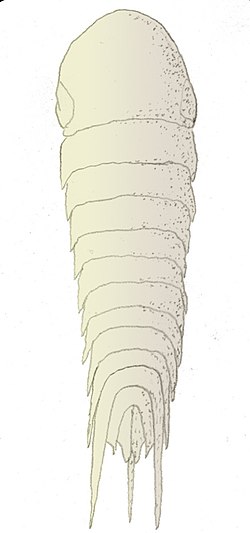アカントメリディオン
アカントメリディオン(Acanthomeridion)は、カンブリア紀に生息した化石節足動物の1属。中国の澄江動物群から発見される種によって知られる[1][2]。
| アカントメリディオン | ||||||||||||
|---|---|---|---|---|---|---|---|---|---|---|---|---|
 Acanthomeridion serratum の復元図
| ||||||||||||
| 地質時代 | ||||||||||||
| カンブリア紀(Cambrian Stage 3) | ||||||||||||
| 分類 | ||||||||||||
| ||||||||||||
| 学名 | ||||||||||||
| Acanthomeridion Hou, Chen & Lu, 1989 | ||||||||||||
| タイプ種 | ||||||||||||
| Acanthomeridion serratum Hou, Chen & Lu, 1989 | ||||||||||||
| 種 | ||||||||||||
|
形態
編集全長35mm程度の縦長い節足動物である[2]。体は丸みを帯びていた頭部と11ないし12節の背板に覆われる胴部から構成されており、尾端の中央は尖った尾節をもつ[2]。頭部左右の領域は三葉虫のように、縫合線によって隔てられている[3][2]。胴部の消化管は対になる消化腺をもつ[2]。付属肢(関節肢)は不明[2]。
分類
編集アカントメリディオンはArtiopoda類(三葉虫・光楯類などを含む大グループ)の節足動物である。その中で、アカントメリディオンはかつてシャンダレラ類(Xanderallida、シャンダレラやシンダレラなどを含んだ群)として分類された[2]。しかし、新たな特徴に基づいた Hou et al., 2016 の分岐学的見解では、アカントメリディオンは他のArtiopoda類より早期に分岐したとされる[2]。
アカントメリディオン属(Acanthomeridion)は Bergstrom & Hou 1997 によって単型科であるアカントメリディオン科(Acanthomeridiidae)に含められた[4]が、Hou et al., 2016 に科不明とされるようになった[2]。1989年に記載され、2008年まででは8つの化石標本のみが知られる[3] Acanthomeridion serratum と、2016年に記載され、3つの化石標本によって知られる Acanthomeridion anacanthus という2種が認められる[2]。
- Acanthomeridion serratum Hou, Chen & Lu, 1989
- 胴部11節、後方数節は左右に長い棘をもつ[2]。
- Acanthomeridion anacanthus Hou et al., 2016
- 胴部12節、後方数節の左右は長い棘を欠く[2]。
脚注
編集- ^ X.-G. Hou, J.-Y. Chen & H.-Z. Lu (1989). “Early Cambrian new arthropods from Chengjiang, Yunnan”. Acta Palaeontologica Sinica 28: 42–57.
- ^ a b c d e f g h i j k l Hou, X; Williams, Mark; Gabbott, Sarah; Siveter, D.J.; Cong, Peiyun; Ma, Xiaoya; Sansom, R (2016-09-01). A new species of the artiopodan arthropod Acanthomeridion from the lower Cambrian Chengjiang Lagerstätte, China, and the phylogenetic significance of the genus. pp. 1–8. doi:10.1080/14772019.2016.1229695.
- ^ a b Xiang-Hong Feng, Xian-guang Hou (2008). The Cambrian Fossils of Chengjiang, China: The Flowering of Early Animal Life. John Wiley & Sons. p. 176
- ^ J. Bergstrom & X. Hou (1997). Arthropods of the Lower Cambrian Chengjiang Fauna, Southwest China. Fossils and Strata 45. Wiley-Blackwell. ISBN 978-82-00-37693-4